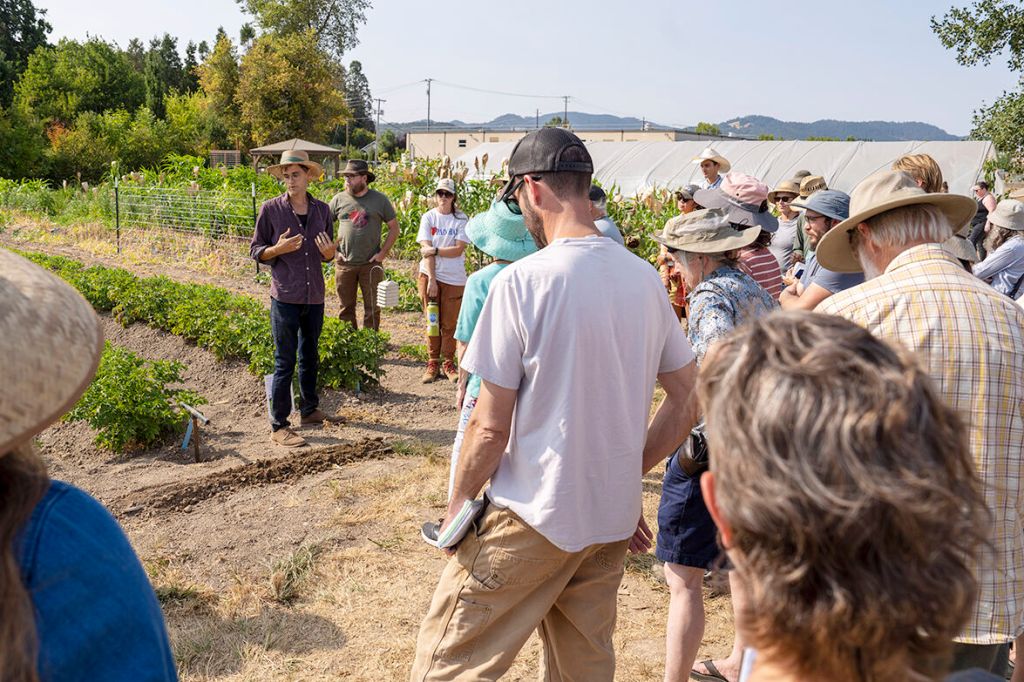Slow and steady: Dry farming on the rise
Published 5:00 am Monday, August 28, 2023

- Lucas Nebert talks about the basics of dry farming to a group attending a free Dry Farm Field Day in August.
Jacques Neukom farms melons, corn and peaches for market with a twist — he doesn’t irrigate them.
Trending
Neukom has been farming for almost 30 years near Willow Creek, Calif., and his farm is one of a growing number participating in the practice of farming without irrigation.
Even without water, his crops are thriving. “The fields where I’m dry farming are vibrant,” he said, “and it’s really neat to see.”
Dry farmers plant crops capable of growing deep roots that can take in water and nutrients from the soil deeper than plants irrigated from the surface with shorter root systems.
Trending
“There’s plenty of moisture in the soil that is typically underappreciated and underutilized in modern agriculture,” said Lucas Nebert, a research associate at Oregon State University whose focus is on dry farming.
The approach works well in climates with wet and dry seasons, where the soil absorbs enough water to sustain plants even after the precipitation stops. That way, even without watering, a plant’s roots grow as the soil dries from the top down during the dry season. Dry farming is rooted in desert and Indigenous farming practices, such as those of the Hopi Tribe in Arizona.
New directory
The Dry Farming Institute, a nonprofit organization focused on offering resources to growers interested in dry farming, is developing a directory of dry farmers in the Pacific Northwest.
Ten farms are currently listed in the directory, but Amy Garrett, director of operations at the institute, estimates that 50 to 100 people are dry farming in Oregon alone.
One of them is Lilliputopia Farm in Monroe, where owner Eliza Mason grows dry farmed tomatoes, melons and zucchini. She recently attended a Dry Farming Field Day at OSU, where people could see OSU’s dry-farmed plot, discuss techniques and ideas, and try dry-farmed melons.
Mason doesn’t have water rights, she said, and her city’s water is expensive. To conserve, Mason turned to dry farming.
“I get a smaller yield but I wanted to move forward without water because getting water is challenging,” she said.
Smaller yield, bigger flavor
Smaller yield is one of dry farming’s drawbacks. But Mason, like Neukom and others, believes any smaller yields are offset by bigger flavor and longer storability.
One kind of melon grown at OSU can store through December, ripening slowly after harvest because the water content molds slower. And with less water to absorb while growing, the crop isn’t watered down and the nutrients are condensed, making dry-farmed food packed with flavor.
However, the crops are sometimes physically smaller for the same reason.
According to Nebert, timing, location, soil health and crop choice are vital for successful dry farming. Planting earlier in the season, in clay-like soil, can sometimes help with increasing yield because the plants start rooting earlier and take in more moisture during the growing season.
Much of Nebert’s work with OSU’s Dry Farming Project, a research program addressing growers’ questions, consists of helping farmers identify which parts of their farms are likely to be successful for dry farming, and which crops could thrive. Outreach like their dry-farming field days helps connect farmers and support a dry farming community.
California success
Neukom has spent the last 29 years figuring out what works well for his 19-acre farm. Willow Creek is close to seven major rivers that are important to nearby Indigenous communities, he said. As a former fisheries biologist, he understands the importance of rivers and fish to native cultures, and he wanted to leave as much water as he could in the Trinity River next to his farm.
With that in mind, he started dry farming. Neukom believes he saves water, labor and organic matter at the same time that he gets better flavors and enough yield to limit his market days to just two per week, along with selling to two local supermarkets and a few restaurants.
“I grow at nature’s pace, and things take time,” Nebert said. “Success is years out. My goal is to be farming when I’m 80. I’m not trying to get rich now so I can be in Cancun. This is it. I’m already in Cancun.”









